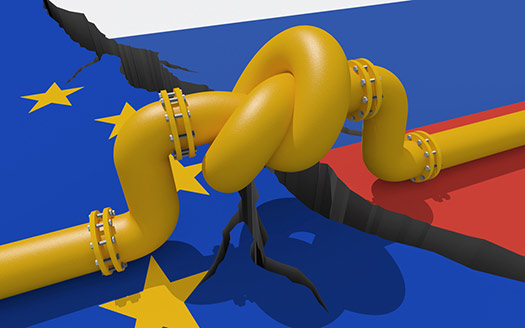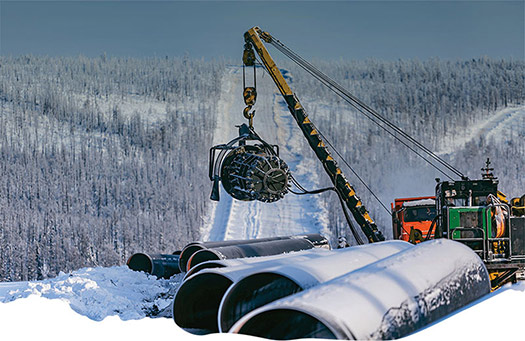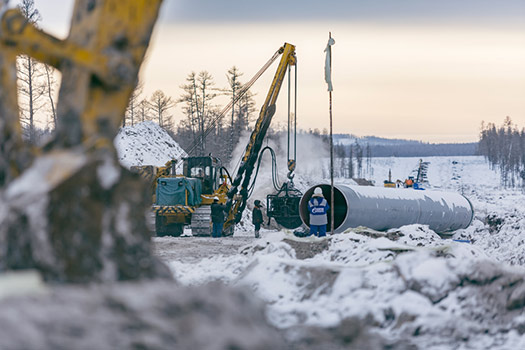November 2023, Vol. 250, No. 11
Features
Russian Pipelines Facing Significant Pressure from Tightening Sanctions
By Eugene Gerden, P&GJ International Correspondent
(P&GJ) — The Russian pipelines’ sector is experiencing serious pressure amid ever tightening sanctions and the ever-growing isolation of the country in the international arena. Historically, pipelines have been a strategic asset in Russia, with the largest volume of cargo coming in the form of crude oil and natural gas.
The total length of main pipelines in Russia is more than 155,300 miles (250,000 km) with pipelines of large diameter such as 48 inches and 56 inches (1,220 mm and 1,420 mm), covering long distances accounting the biggest share.
After Feb. 24, 2022, however, the pipeline sector of Russia faced an unprecedented crisis brought about by a significant decline of supplies of both oil and gas to West and serious problems associated with technical maintenance of existing capacities.
This came about even though the anti-Russian sanctions do not contain a complete ban on gas supplies to Europe via pipelines. The dependence on Russian gas supplies remains high in many E.U. countries. Still, the fallout from the war in Ukraine significantly complicates further supplies of Russian gas on the majority of western markets.
According to analysts, the latest restrictions against Russia could limit the construction of new gas pipelines in the country and hamper the operation of the existing pipelines. The United States has recently imposed a ban on the exportation and re-exportation of gas turbines of all types and sizes – as well as parts for them – to both Russia and Belarus.
The banned equipment, according to Russian Ministry of Energy, is used at major facilities in the country, particularly at the compressor stations of the Bovanenkovo-Ukhta and Power of Siberia gas pipelines.
The Russkaya station, which is the head compressor station of the TurkStream project, as well as at the Amur Gas Processing Plant and Sakhalin 2 LNG project, in Sakhalin Island, are among them.
Overall, the imposition of the ban posed a threat for the majority of existing major large-scale gas pipeline projects in Russia, which includes the construction of the Power of Siberia 2 and Eastern Route to China. It also brings into question the ability of Russia to expand its gas supplies to Turkey, as well as plans to triple LNG production by 2030 from 33 mtpa to 100 mtpa.
While the repair of imported equipment by Russian specialists is currently possible, there are no guarantees equipment will continue to come from suppliers.
According Olga Panina, head State and Municipal Management at the Russian Financial University, despite the departure of the main manufacturers of high-capacity gas turbines from Russia, such as Siemens and Baker Hughes, single deliveries of such equipment until today have been carried out, although these were seriously complicated. However, it is currently unclear whether these supplies will continue amid the conditions of regular tightening of sanctions, she said.
To address the matter, Russian has accelerated its search for new suppliers abroad, particularly in so-called “friendly” countries, such as Iran and China. Attention will also be paid to the secondary market due to the need for spare parts and gas turbines.
In addition, there is the possibility starting to receive original equipment from other countries, most likely through Turkey or China, through the various legal and semi-legal schemes, despite the consequences.
Another option for Russia involves the establishment of a large and medium gas turbine production sector within the country, although that would require a great deal of time and money.
The need for large turbines is an acute need for Russia and its gas pipelines sector. The government hopes to avoid the repeat of what happened last year when the breakdown of a turbine and the lack of access to repairs, led to a significant decrease in the capacity of gas pumping through the Nord Stream to Europe.
There are several companies in Russia that can produce gas turbines and components: INGK, REP Holding and UEC, among them. However, none of them can produce high-power turbines.
Nonetheless, in December 2022, Power Machines, a Russian energy systems machine-building company, announced it had completed the assembly of the prototype of a high-capacity gas turbine the GTE-170. The turbine has passed the inspection of control operations at the St. Petersburg Metal Plant.
Power Machines plans to produce as many as eight such turbines per year and will provide service for turbines, beginning in 2025. The demand for these turbines by the Russian pipeline sector is estimated by analysts to be 27 by 2027.
With Russia searching for alternative markets to the West, the need to develop new pipeline projects and other infrastructure should be significant. In partial response, Russia plans to transfer part of its gas export volumes to the Black Sea region, particularly for the Turkish gas hub.
Under the terms of this project, the total capacity to be shipped beneath the Black Sea will be 63 Bcm/a. Given the already existing Turkish Stream, 31.5 Bcm/a of additional capacity is needed.
According to Alexei Miller, chairman of Gazprom, the lost capacities in the north in the Baltic, can be transferred to the Black Sea. He said that the Black Sea route is much safer and more convenient, because the depth of the sea there is much greater – 1.2 (2 km),150 meters vs. 210 meters.
In case of the E.U., Russian gas is still supplied Europe through pipelines that include the TurkStream, although less than is flowing through Ukraine. Among the E.U. countries, which continue the deliveries of pipeline gas from Russia, are Hungary, the Czech Republic and Slovakia consume Russian pipeline gas. So does Italy, which plans to continue supplies at least until 2025. These volumes, of course, do not approach those of previous years.
In the first quarter of 2021, Gazprom covered 40% of Europe’s gas needs. In 2022 that amount fell to 28% – this year it is down to 7.5%. Last winter, was not a catastrophe for the E.U. either, although in order to replace volumes from Russia, the region had to buy expensive LNG, which accelerated inflation in Europe.









Comments